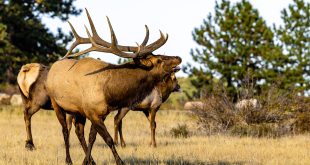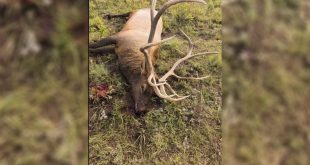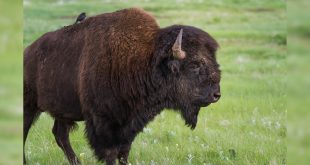Bullwinkle
By Terry Nelson | ELK-WY-DIY-PL
August 31st, the day before the Wyoming archery opener, my pickup is loaded and I’m off… but not to elk camp. Instead I was headed back to work in the oilfield for a two week stint, where it’s going to be difficult to focus because you know that the elk rut is kicking off while you’re stuck at work. Stuck (and possibly sulking) while others are chasing screaming bulls. Let’s not even mention all those inevitable, unavoidable, unforgettable big bull pictures soon to be up on social media. You begin to realize that every bull you’ve scouted over the course of the summer is probably not going to be in the same area. You begin questioning where you were going to start first and what your strategies would be. My arrival on September 15th meant that early season tactics would begin fading out by the time I hit the mountain. That bulls would be feeling the hunting pressure and would be a little call shy. But any experienced hunter knows that every season is different and never really knows what to expect until they arrive.
After completing my last 12 hour shift, I head straight for the mountain. The 11 hour drive can’t go fast enough; Mtn Ops “Yeti”, sunflower seeds, and a short nap, play a role in my midnight arrival at the trailhead. As my 4 a.m. alarm rings, I hop out of the pickup, and begin gathering my gear. While going over my gear list, making sure I’m not forgetting anything, I begin to hear bugles. As anyone that lives for this time of year knows, this sends that rush of hand-clenching, heart-racing adrenaline into my veins and I begin to shake. With a smile from ear to ear, I whisper to myself, here we go… you’ve waited all year for this!
Become a member to read the full article.
Already a subscriber? Login to read the full article.

On the hike in, I take it nice and slow, hunting my way in. As the sun comes up, the bugles begin to fade. It seems as if the elk are already moving into their bedding areas. After a three mile hike I arrive at my planned spike camp, I look up and pick out a half dozen cow elk bedded in the shade. Being the middle of September, the middle of the rut, I knew there was no way those cows were by themselves. I get to where I can put my binos to work and it doesn’t take long till I pick a bull just up the hill from the cows. After arguing with myself for over an hour if this bull was a first day shooter or not, I decide to pass. I fall back and set up camp.
The forecast predicts mid to high 80’s for the period I am going to be up here. I know that I will need to get started well before sunrise to catch anything moving and water sources will be hot spots for all big game. There is plenty of elk activity over the first five days; from chasing a big herd bull for three and messing with little satellite bulls in between. But I think the biggest highlight of those first few days is having a raghorn 5-point sniff the end of my arrow. When that arrow touched his nose, I’m not sure who jumped more!

Then day six rolls around. My 10 day trip is officially halfway over. This is typically when I start to drop my standards and just start looking to fill my tag. With the morning hunt being slow and the sun getting high in the sky, I decide to go look into some well used bedding areas that are close to water. This is where my scouting pays off! I am able to cover ground quickly and slow down when close to bedding areas. The first bedding area I check, there is a raghorn laying 50 yards into it. I know there has to be a herd close as little bulls typically skirt one during the rut. I go up on a vantage point and glass into a few nearby bedding areas and pick out two cows bedded down, then three, then the next thing I know, I see over a dozen cows in the timber. Just not the herd bull. With a mid-day temperature of 80 degrees, I figure they will be moving to water soon. Using my onX Maps, I discover the elk are bedded 370 yards from the nearest water source. I plan to get there, set up, and wait.
As I begin my descent to the bench below me, I notice the herd already on the move. What I thought would be a slow, quiet, descent turns into a foot race, man vs. elk, with the water being the predicted finish line. I sprint down the hill as fast as I can, looking for a spot to drop into the aspen thicket in the bottom. I look up and there stands the herd at just 40 yards. Seventeen cows with the previously elusive herd bull spinning circles in the middle, possibly wondering why a few of his cows are spooking.
I come to a halt… something is different about this bull… his rack… something seems off. I nock an arrow and draw back waiting for the cows to clear. The strange herd bull faces away and frustratingly for me, follows his cows straight away. Failed opportunity #1. I let down my bow and gain elevation as quickly as possible. I figure if I can get above them, I can keep an eye on them. The herd stays down in the aspen thicket and moves down the hill, while I skirt them, trying to keep the wind in my favor.
The herd ended up stopping 400 yards down the hill from where I spooked them. Yet they still want the water. After milling around for a short hour, the herd begins moving back up the hill. I stay in the cover and make my way up to the water. Upon arrival, the rich, musty smell of elk protrudes from the mud and clouded water as they have been frequenting this spot. I set up and begin to hear the cows chirping and the bull glunking and chuckling roughly 100 yards down the hill. I check the wind, perfect! This is going to be it. Finally, two cows come to the water, 20 yards from me. I hear the bull getting closer…closer…and closer until I can make him out through the aspens. He is coming to round up the cows in front of me! This is going to be a close shot. The bull is at 40 yards when I draw back, 30, 25…25…25. The bull stops at 25 yards with a small cedar covering his vitals. There’s no way he’s not coming all the way to the water, or so I think. The bull knows something isn’t right, spins around, and heads back to the rest of the herd. Failed attempt #2.
I run back up onto the hill only to find the herd in chaos. Two satellite bulls are crashing the party and elk are running in all directions as the herd bull is defending his harem. I take this opportunity to slide in close to the herd, as yet another satellite bull is trying to pick off a cow. As I am slipping in close to the herd, I find myself in a stand-off with one of the biggest bulls I’ve seen yet. With him staring right back at me, there is no time to range. I guess 60 yards, draw back, talk myself through the shot. With my pin settled, I ease the trigger and let the arrow fly. The arrow drops below the target, the bull spins out of there running into the pines. I spend the rest of the evening looking for the arrow and blood with neither found. I track the bull and am able to get eyes on him again to verify the arrow never hit its mark. Failed attempt #3.
They talk about the lowest of lows, I was at that point. I practice year round for these opportunities and when I don’t capitalize, it’s beyond frustrating.
I hadn’t blown the big herd out of the area, so I go there the next day, only to hear the squeak of a small bull. I stick to glassing and listening the rest of the day trying to locate the herd before making a play. Just before dark, I put eyes on them. They are a few hundred yards out on private land but I know where I need to be first thing in the morning. I glass the herd bull over and realize his right side is all palmated on the top end. “Bullwinkle”, I thought.
Morning of day #8, I leave spike camp an hour before daylight. I make it to the ridge above where I have seen the herd the previous evening. Bullwinkle sounds off right at the crack of daylight. There is a big wallow on public land that is going to be the nearest water source for these elk. It is time to move.

I make it down the hill quickly to the wallow and find the main trail from there to where the elk are. When the sun begins to break the horizon, the bull begins to move his cows. They are coming my way! I tuck into the trees with a good setup, 30 yards off the trail, with shooting lanes out to 45 yards if needed. I begin to hear the cows chirping and the bull screaming as he moves them along. Once again, I hear elk scattering. I think there is no way they busted me, as the wind and thermals are perfect. That sinking feeling of possibly blown attempt #4 is hitting me, but then I see horns clearing the sage brush. It is a bull running in my direction. Wait, it’s two! A small satellite 6-point and Bullwinkle hot on his heels.
I draw back, the small 6 doesn’t veer from his course. He is going to run right into me! I side step behind a small pine to my left as the satellite bull runs an arm’s length from me. I step back out just in time to get my sights on Bullwinkle standing at 30 yards with nothing but his rear facing me. He finally takes a side step watching the satellite bull below, just enough where I can see the crease of his shoulder. I settle the pin on the crease and send my arrow flying. WHOP! The arrow hits its mark perfectly, and Bullwinkle hunches up and runs down the hill into the small meadow in the bottom. He stops 50 yards below me, out in the open as his legs give out from underneath him. He expires in less than 30 seconds. Finally, it had all come together.

After I walk up on the bull, admiring everything about him, and paying my respects, it is time to call in the troops. I am going to need help for the four mile packout. The guys left work right away and are on the mountain in less than three hours. Having good buddies that drop what they’re doing to come pack out an elk is priceless. The day is already heating up so we need to get this bull broken down and into the shade. Once at the pickup, we recover and celebrate.

After the nerves settle, I find myself in a moment of reflection. Giving thanks to God for blessing me with the life and opportunities I have. Also having a small talk with my dad, who was been watching from heaven, thanking him for teaching me how to hunt and just as importantly how to embrace failure. The failures just meant I needed to adapt and work harder to achieve success. Persistence and determination played a big part in the success of this hunt. With several missed opportunities in those 8 days, I can look back and not consider them failures but lessons for future seasons.

 Eastmans' Official Blog | Mule Deer, Antelope, Elk Hunting and Bowhunting Magazine | Eastmans' Hunting Journals
Eastmans' Official Blog | Mule Deer, Antelope, Elk Hunting and Bowhunting Magazine | Eastmans' Hunting Journals





Terry,
What an awesome story. And congrats on a beautiful bull !!
Dale